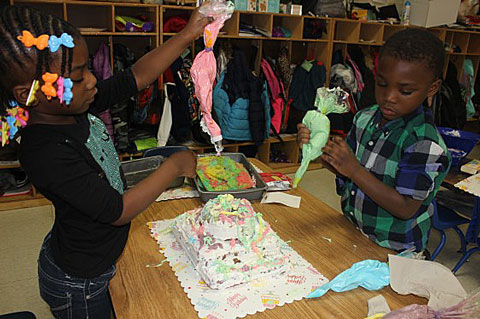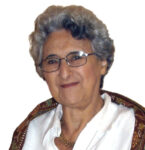
One main reason for doing projects is to get children into the habit of “unpacking” a topic and of exploring it in depth and, in that way, gaining a sense of mastery of it.
I often suggest to teachers that one of the important goals of early education is to help children to make better, fuller, and deeper sense of their own experience and their own environment. But every once in a while I hear a teacher—usually one who works with low-income children—claim that those children “have no experience.”
The first time I heard that comment at a meeting of Head Start teachers, I suggested that surely all of the children have some direct contact with food! So any group of children could be encouraged to deepen their awareness, knowledge, and understanding of food and related phenomena through a good extended project investigation.
Such a project should go well beyond “favorites” and the cutting out and pasting of pictures of foods. Here are some suggested possibilities.
Children are likely to have strong memories connected with food. They may recall trying a new food for the first time, or going to a favorite restaurant, or cooking something with Grandmother, or having to taste something they didn’t like, or perhaps even going without food when they were hungry. During Phase 1, you can help them explore and represent their experiences with foods.
Most preschoolers can get involved in seeking answers to the following questions and collecting information that will answer them:
- What are some foods you don’t like?
- What don’t you like about them?
- Is it the taste, the smell, the color, the texture (too crunchy, slimy, creamy) etc.?
- Is the taste bitter, sweet, spicy, salty, etc.?
(Each of these terms above can be studied empirically!)
Preschoolers can also involve family members and other experts in finding the answers to such questions as:
- Which food items have to be cooked before being eaten?
- Which can be eaten raw?
- Which foods can be eaten either raw or cooked?
- Which food items have to be peeled? What happens if you don’t peel them?
- Which food items are usually chopped? Grated? Mashed? Ground?
- Which have to be stirred? Baked? Boiled? Broiled? Grilled? Frozen? Fried? Poached? Barbequed? Steamed? Or all of the above?
- What are the differences among such food preparation procedures as boiling, steaming, poaching, baking, roasting, etc.?
- What tools, machines, and equipment help people to prepare food in all these ways?
Make sure most of the children understand what these tools and procedures are. Talk about the meanings of the words and provide opportunities for them to chop, grate, bake, freeze, and so on during their fieldwork.
With adults to help them proceed safely, children can conduct fieldwork to find answers to questions like:
- Have you ever noticed what gets soft when it is cooked? (e.g., potatoes, apples) and which foods get hard when cooked? (e.g., eggs, dough).
- Which foods change color when cooked? (e.g., butter, meat)
- If you prepare a food item more than one way (say, frying one egg and boiling another), what are some differences in taste, color, texture, etc.?
- When a recipe says to cook a food for a certain amount of time, what happens if you cook it longer? Not as long?
- Do foods always taste the way they smell?
Children can involve their families and neighbors by conducting surveys at home. Questions might include:
- What are the likes and dislikes of others in your family? Of your neighbors?
- How many kinds of cereal do you have on hand? How many cans of food?
During field trips and conversations with experts, children can get answers to questions like:
- What foods are stored in the refrigerator? The freezer section? A cupboard? Cabinet? etc.?
- Which food items are stored or bought in cans? Cartons? Boxes? Jars? Bottles?
- What are the differences between
- a jar and a bottle?
- a box and a carton?
- a vegetable and a fruit? etc?
- How many kinds of crackers/cereal/fruit/beans are in the store or supermarket where you go?
- What makes something a food, while other things are not foods? What things do you swallow that are not food? (e.g., soda, cough medicine, other medicines.)
Don’t underestimate the children’s abilities to be nosey and find out things about foods. And as they find answers to these questions, expect them to come up with many more questions as well. Encourage them to take pleasure in using their new knowledge. See if they can think of ways to turn the dramatic play area into a kitchen, restaurant, or grocery store. Let them prepare food to share at snack time or to serve to peers or their families. Have them invite their families to share traditional or favorite foods with the class. Tasting something while blindfolded and guessing what it is may be an enjoyable challenge for some children. There is almost no end to this topic!
After hearing me speak about food projects, my colleague Jean Mendoza shared some of her experiences with me, which I have incorporated into this blog entry.


 Printer-friendly PDF
Printer-friendly PDF Lilian Katz
Lilian Katz
 Printer-friendly PDF
Printer-friendly PDF